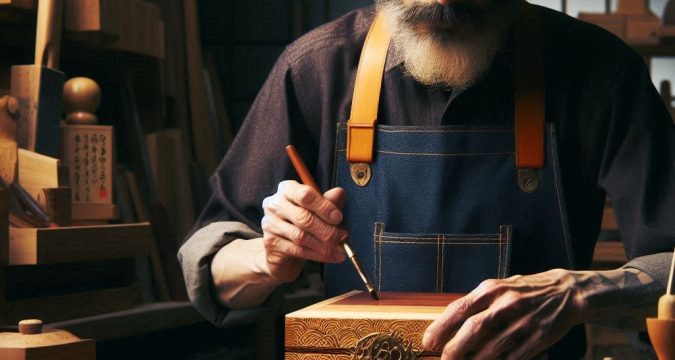
Urushi lacquer, a cornerstone of traditional Japanese craftsmanship, has captivated artisans and enthusiasts for centuries. This ancient technique transforms ordinary objects into extraordinary works of art, blending functionality with breathtaking beauty. In this comprehensive guide, we’ll delve into the world of urushi lacquer, exploring its history, techniques, and contemporary applications.
Introduction
Urushi lacquer is a natural varnish derived from the sap of the urushi tree (Toxicodendron vernicifluum). This versatile material has been used in Japan for over 9,000 years, adorning everything from everyday utensils to luxurious art pieces. Its durability, lustrous finish, and rich cultural significance have made it an integral part of Japanese artistic heritage.
Key Takeaways
| Aspect | Details |
|---|---|
| Origin | Derived from the sap of the urushi tree |
| Age | Used in Japan for over 9,000 years |
| Applications | Utensils, furniture, art pieces |
| Characteristics | Durable, lustrous finish, culturally significant |
| Techniques | Various, including maki-e and raden |
The History of Urushi Lacquer
Urushi lacquer’s journey through Japanese history is as fascinating as the art itself. Archaeological evidence suggests that urushi was used as an adhesive as early as the Jōmon period (14,000-300 BCE). Over time, its application evolved from purely functional to decorative, reaching its artistic zenith during the Edo period (1603-1868).
During the Meiji era (1868-1912), urushi artisans faced challenges as Japan opened to Western influences. However, this period also saw a revival of traditional crafts, with urushi lacquer gaining international recognition at world expositions.
The Urushi Lacquer Process
Creating urushi lacquerware is a meticulous process that requires patience, skill, and an understanding of the material’s unique properties.
Harvesting and Refining Urushi Sap
The process begins with harvesting sap from the urushi tree. Perform this task is traditionally during the summer months when the sap flows most freely. The collected sap undergoes a refining process to remove impurities and adjust its consistency.
Preparing the Base
Before applying urushi, artisans must prepare the base material, typically wood, bamboo, or cloth. The surface is carefully smoothed and sometimes covered with a foundation layer of cloth or paper to prevent cracking.
Applying Urushi Layers
The application of urushi is a time-consuming process involving multiple thin layers. Cure each layer in a humid environment before applying the next. This process can take weeks or even months, depending on the desired finish and complexity of the piece.
Polishing and Finishing
After the final layer of urushi has cured, the surface is meticulously polished to achieve its characteristic glossy finish. This step requires great skill to avoid damaging the delicate lacquer surface.
Decorative Techniques in Urushi Lacquerware
Urushi artisans have developed a variety of techniques to create stunning decorative effects:
Maki-e
Maki-e, or “sprinkled picture,” involves sprinkling gold or silver powder onto wet urushi to create intricate designs. This technique produces remarkably detailed images and is considered one of the highest forms of urushi art.
Raden
Raden incorporates mother-of-pearl inlays into the lacquer surface. The iridescent quality of the shell creates a beautiful contrast with the deep, rich tones of the urushi.
Chinkin
Chinkin involves carving designs into the dried urushi surface and filling the grooves with gold powder or leaf. This technique creates a striking textural contrast between the smooth lacquer and the raised gold design.
Contemporary Applications of Urushi Lacquer
While deeply rooted in tradition, urushi lacquer continues to evolve and find new applications in contemporary art and design.
Modern Urushi Art
Contemporary artists are pushing the boundaries of urushi, creating innovative works that blend traditional techniques with modern aesthetics. These pieces often incorporate unconventional materials or explore abstract forms.
Urushi in Product Design
Designers are increasingly incorporating urushi into modern product design, from high-end furniture to luxury accessories. The material’s durability and unique aesthetic make it an attractive option for creating distinctive, long-lasting pieces.
Preserving and Caring for Urushi Lacquerware
Proper care is essential to maintain the beauty of urushi lacquerware for generations:
- Avoid extreme temperatures and humidity
- Clean gently with a soft, dry cloth
- Store pieces away from direct sunlight
- Handle with clean, dry hands to prevent oils from damaging the finish
The Future of Urushi Lacquer
As we look to the future, the art of urushi lacquer faces both challenges and opportunities. Efforts are being made to ensure the continuation of this craft through education and innovation, while also exploring sustainable harvesting practices for urushi sap.
FAQs
- Is urushi lacquer safe to use on food-contact surfaces?
Yes, properly cured urushi lacquer is food-safe and has been used for centuries on dining utensils and tableware. - How long does it take to create a piece of urushi lacquerware?
The process can take anywhere from several weeks to several months, depending on the complexity of the piece and the number of layers applied. - Can urushi lacquer be applied to materials other than wood?
Yes, urushi can be applied to various materials including metal, plastic, and even glass, though wood remains the most traditional base. - Is urushi lacquer environmentally friendly?
While urushi is a natural material, sustainable harvesting practices are crucial. Some artisans are exploring alternative sources and synthetic versions to reduce environmental impact. - How can I learn urushi lacquer techniques?
Many traditional craft schools in Japan offer urushi courses. Some international art schools also provide workshops or specialized programs in urushi techniques.
By exploring the rich history, intricate techniques, and contemporary applications of urushi lacquer, we gain a deeper appreciation for this remarkable art form. As we look to the future, the continued practice and innovation in urushi lacquerware ensure that this ancient craft will continue to captivate and inspire for generations to come.
External sources:

